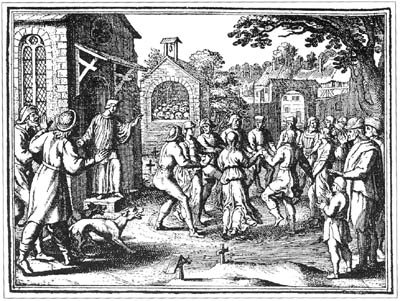
The Dancing Plague (or Dance Epidemic) of 1518 was a case of
dancing mania that occurred in Strasbourg, Alsace (then part of the Holy Roman
Empire) in July 1518. Around 400 people took to dancing for days without rest, and,
over the period of about one month, some of those affected died of heart
attack, stroke, or exhaustion.
The outbreak began in July 1518, when a woman, Frau
Troffea, began to violently dance in the
streets of the city of Strasbourg, France. There was no music and her face
betrayed no expression of joy. She appeared unable to stop herself from her
frenzy.
Had this remained an isolated incident, the city elders may
have put it down to madness or demonic possession, but soon after Troffea began
her dancing, a neighbor joined in. And then another. By the end of a week more
than 30 people were dancing night and day on the streets of the city. And it
didn’t stop there. By the time a month had passed, at least 400 citizens of
Strasbourg were swept up in the phenomenon.

Medical and civic authorities were called in once some of
the dancers began dying from heart attacks, exhaustion, or strokes. As the
dancing plague worsened, concerned nobles sought the advice of local
physicians, who ruled out astrological and supernatural causes, instead
announcing that the plague was a "natural disease" caused by
"hot blood. For some inexplicable reason, these men believed that the cure
for the dancing was more dancing, so they erected a wooden stage for the
dancers and musicians were called in.
This all sounds like some archaic bit of folklore, but the
dancing plague of 1518 is clearly chronicled in medical, civic, and religious
notes of the time.
Modern researchers pore over those notes to develop theories
as to what caused this bizarre incident.
One of those theories postulates that the dancers were the
victims of mass hysteria: instances when more than one person believes they are
afflicted by an identical malady — often during times of extreme stress within
the affected community. The Strasbourg incident occurred during a time of
rampant famine and malnutrition and subsequent deaths. But 400 people? A
well-known recent incident generally seen as an example of mass hysteria is
1962’s “The Tanganyika Laughter Epidemic” which affected only 95 people.
A second theory is in the realm of agriculture. The
condition called Ergotism occurs when grains of rye are attacked by a specific
mold. Eating the infected rye can lead to seizures, although the movements of
Strasbourg’s afflicted looked much more like traditional dancing than seizures
of any sort.
A final school of thought states that the dancing was in
result of some kind of religious ecstasy caused by veneration of Saint Vitus,
the patron saint of epilepsy.
None of the theories completely explain the 1518 dancing.
0 comments:
Post a Comment
please leave your opinion about his blog ,
this will help us to give some more quality information.